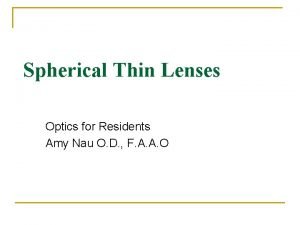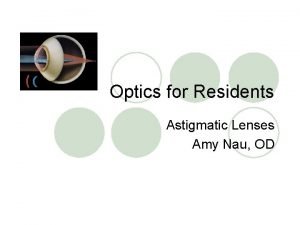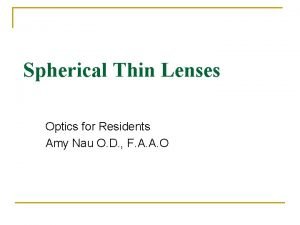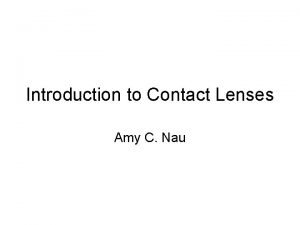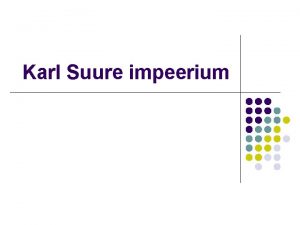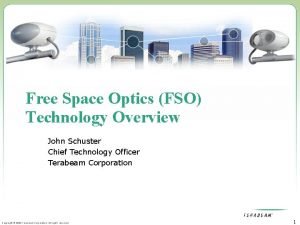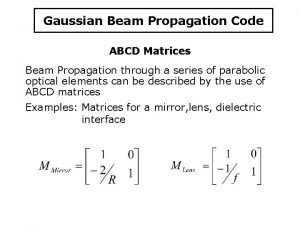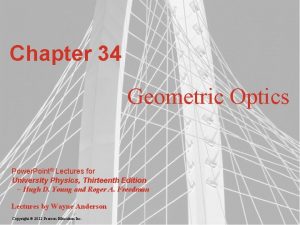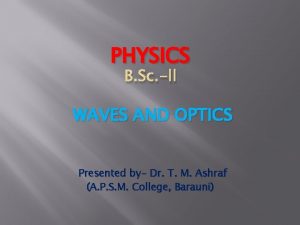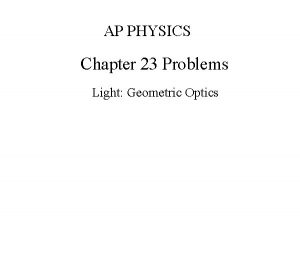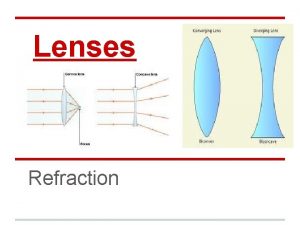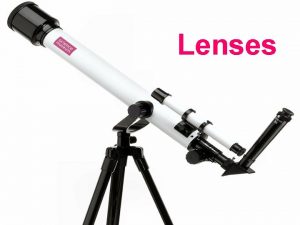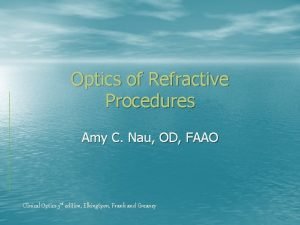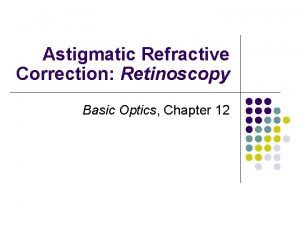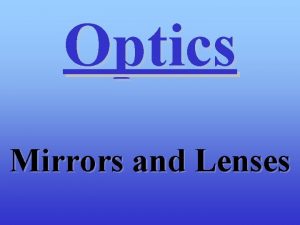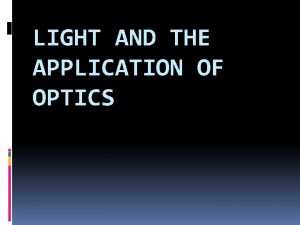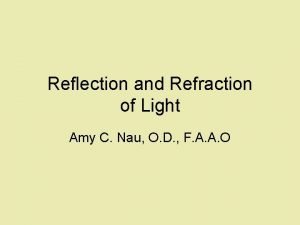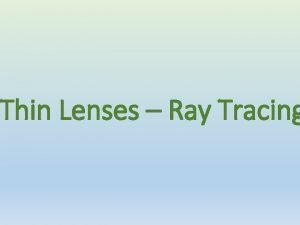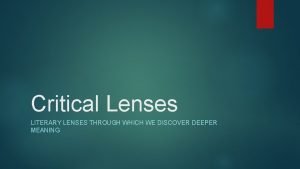Optics for Residents Astigmatic Lenses Amy Nau OD

































- Slides: 33

Optics for Residents Astigmatic Lenses Amy Nau, OD

Astigmatic Lenses l Spherical lenses form a point image for each object point ¡Stigmatic = point-like l Toroidal are not-point-like ¡Astigmatic! ¡This is a second order aberration

Toroidal Surfaces The surface is created by two radii of unequal length, Each in a plane at right angle to the other Vertical plane 1 r 1=r 2 P=n 1 -n 2/r For any object vergence, a toric Surface creates two separate images. 2 H pl ori an zo e nt al

The astigmatic image- plano cyl r 1 r 1 r 2 Looks like a stack of thin plus lenses, each Of the same refracting power

The astigmatic lens- plano cyl Cylinder axis Say each lens has P=5 D. Then if we put an Object 50 cm in front of them, EACH lens forms A point image 33 cm away. The final composite image will be a series of Points oriented in a straight vertical line r 1 x HORIZONTAL plano-cyl LENS FORMS VERTICAL LINE IMAGE X’ X’ X’

Astigmatic Lenses-plano cyl Ho X’ riz on ta X’ ll in e im X’ ag e X’ x VERTICAL plano cyl LENS FORMS HORIZONTAL LINE IMAGE

Astigmatic Lens- plano cyl r 1 is shorter than r 2, so the power of r 1 will be greater than r 2. Vertical plane F=n 1 -n 2/r 1 Therefore, the VERGENCE of the two Powers will be different 2 H pl ori an zo e nt Recall do+di=1/f al and F=1/f So, if F 1>F 2, then di 2 is farther from The lens than di 1

Astigmatic Lens- plano cyl All toroidal surfaces have two major meridians- the one with the max power and the one with minimal power 90 degrees away. Each will form a line image, so what happens in the plano (no power) meridian? Vertical lens Each horizontal slice Has parallel faces w/o Curvature and thus no power. Same Alignment as axis.

Problem type Find the powers of a plano cyl lens using radius information. Determine image position using radius information.

Maddox Rod Ho riz on ta X’ X’ X’ ll in e im ag e x X Re Be al ho hin riz d t ont he a ey l line e im ag e point source THE MADDOX ROD IS A STACK OF THESE LENSES ALL TOGETHER. Position of virtual, vertical line image, same position as X This is what the patient sees

Maddox Rod l This vertical line image is virtual l Cannot be focused on a screen l CAN be seen when looked at through the lens towards X. X Since the eye is very close to the lens, the horizontal line is not seen. The eye then sees the virtual, VERTICAL image line that appears to be Located at the object point (where the light is).

Maddox Rod Eye sees VIRTUAL horizontal image Eye sees VIRTUAL vertical image Remember the eye behind the red lens (OD) deviates in the direction OPPOSITE to that of the virtual red line.

Problem Type l Know generally how Maddox rod works. l Know what occurs clinically!

The Cross Diagram Take the example some power, P x 180 This has a maximum power is located in the vertical meridian. {An equivalent expression would be P@90 - this is how K’s are expressed. } +1. 00 = +2. 00 x 180 +1. 00 +2. 00 +3. 00 = +1. 00 pl +1. 00

Transpositon +3. 00 = -2. 00 x 090 +3. 00 pl +3. 00 = +1. 00 Combined cyl +3. 00 -2. 00

Transposition +3. 00 = -2. 00 x 090 is same as +1. 00= +2. 00 X 180 +2. 00 +1. 00 +3. 00 = +1. 00 pl

Problem Types Be able to convert an Rx into a cross diagram Be able to convert a cross diagram into an Rx Know how to transform between plus and minus cyl Draw cross diagrams in plus and minus form

The Circle of Least Confusion +3. 00 x 180 X’v X’h +5. 00 x 090 x 20 cm 33 cm

The Circle of Least Confusion Interval of Sturm - distance between the two line images X’v X’h x CLC

CLC l Vergence at the clc is the average emergent vergence leaving the lens. l Lc=L 1+L 2/2 l The location of the clc is the reciprocal of Lc

The Circle of Least Confusion +8. 00+2. 00 x 180 2 8 8 Object is placed 1 m in front of this lens. L’=F+L L’=10 -1=9 D and l’=11. 11 cm L’’=F+L L’’=8 -1=7 D and l’’=14. 28 cm Location of clc = reciprocal of average verg. L’c=L’+L’’/2 = (9+7)/2 = 8 D; and l’c=1/L’c so, l’c=1/8 =12. 5 cm 10 pl 8

Spherical equivalent l Take ½ the cyl and add to sphere l -4. 00+1. 00 x 180 becomes l -3. 50 D l Good for patients who can’t tolerate cyl in spectacles l Good for contact lenses

Problem types Understand the terminology Know how to calculate the length of the conoid of Sturm Know how to find the spherical equivalent in an Rx Know how to locate the CLC

Meridional Powers of Cyl Lenses What about the powers between the major meridians? ? ? The power gradation from max to min is NOT a straight line change; the power gain moving from the axis meridian (min) to the maximum increases by the sin 2 of the angle away from the axis. 60 F(sin 2 f) In this 3 D cyl, the power in the meridian 60 to the axis is 3(sin 260) = 3(. 866)2 = 3(. 75) = +2. 25 D

Meridional power of cyl lenses l Important OKAP Factoid l For any spherocylinder lens, the power in the meridian 45 degrees to the axis (that is, halfway between the max and min meridional powers) is always the spherical equivalent of that lens.

Problem type l Be able to calculate an off axis power l What is the power at 45 degrees? l -1. 00 -2. 00 x 180? A. -1. 50 D

Differential Motion of Line Images P 1 @ 090 P 2 @ 180 -p 3 @ 180 +3 D sph P 1 P 2

Jackson Cross Cylinder A toric lens that is composed of a + cyl and – cyl of equal powers ground on to one lens, with their axes at right angles To each other. The strength of the cyl is always two times, and of opposite sign to the power of the sphere +1. 00 = -2. 00 x 180 or -0. 25 + 0. 50 x 090 ALL CROSS CYL LENSES HAVE AN EQUIVALENT POWER OF ZERO THUS, THE CLC WILL NOT BE MOVED! - + Plus axis at 90 - + + + - The meridians marked are the axes! Plus axis at 180

JCC for power refinement Clinically, the CLC is placed as Close to the retina as possible Using the sphere powers (usually the spherical equivalent). Then The patient can determine if the size of the blur circle increases or decreases As soon as the patient can no longer tell the difference, then the Interval of sturm is collapsed, and there is “no more” astigmatism.

Cyl orientation (convention) The 0 -180 axis (horizontal) 0 begins at the patients LEFT ear and rotates counterclockwise when you are facing the patient. This is true for both eyes. 120 deg 180 30 deg 0 Left reference ear

Problem type l Be able to recognize a JCC in Rx form l Be able to write JCC in Rx format l Understand how it works in general terms.

Free Optics Textbook online l http: //www. lightandmatter. com/bk 5 a. pdf

Learning Goals l Nature of torics l Maddox rod optics l Cross diagrams l Transposition l CLC l Images formed by torics l Manipulation of image position l Meridional (off axis) powers l Optics of the JCC
 The astigmatic poem analysis
The astigmatic poem analysis Venn diagram of geometric optics and physical optics
Venn diagram of geometric optics and physical optics Difference between ray optics and wave optics
Difference between ray optics and wave optics Power of lens formula class 10
Power of lens formula class 10 Nau optics
Nau optics Iso-accommodative magnification
Iso-accommodative magnification Nau optical
Nau optical Amy nau
Amy nau Karl suure tähtsaim residents
Karl suure tähtsaim residents Uihc internal medicine residency
Uihc internal medicine residency Famous yonkers residents
Famous yonkers residents Post campaign analysis presentation
Post campaign analysis presentation Umass pharmacy residency
Umass pharmacy residency Internal tourism includes
Internal tourism includes Tufts neurology residency
Tufts neurology residency St louis family medicine residency
St louis family medicine residency Unm emergency medicine residents
Unm emergency medicine residents Dr kirk kleinfeld
Dr kirk kleinfeld How can an na best help residents with eating?
How can an na best help residents with eating? Unmc oasis
Unmc oasis Uf neurology residency
Uf neurology residency Uthscsa family medicine residency
Uthscsa family medicine residency Https://ncc-efm.org/game/efmgame.cfm
Https://ncc-efm.org/game/efmgame.cfm Chapter 6 personal care skills
Chapter 6 personal care skills Dr. marina spudic
Dr. marina spudic Uw neurosurgery residents
Uw neurosurgery residents Physics 2
Physics 2 Free space optics
Free space optics Phuong than
Phuong than Abcd matrix gaussian beam
Abcd matrix gaussian beam Geometric optics ppt
Geometric optics ppt Wave optics b.sc physics
Wave optics b.sc physics Optics
Optics Purdue phys 241
Purdue phys 241



